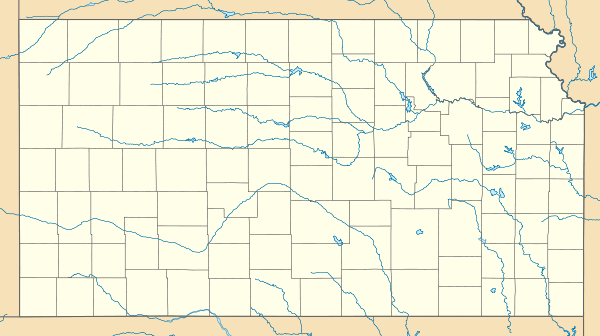Wolf Creek Generating Station
| Wolf Creek Generating Station | |
|---|---|
 | |
 Location of Wolf Creek Generating Station in Kansas | |
| Country | United States |
| Location | Hampden Township, Coffey County, near Burlington, Kansas |
| Coordinates | 38°14′20″N 95°41′20″W / 38.23889°N 95.68889°WCoordinates: 38°14′20″N 95°41′20″W / 38.23889°N 95.68889°W |
| Status | Open |
| Construction began | 1977 |
| Commission date | September 3, 1985 (Commercial Operation) |
| Construction cost | $3.05 Billion |
| Owner(s) |
Westar Energy (47%), Kansas City Power and Light Company (47%), Kansas Electric Power Cooperative (6%) |
| Operator(s) | Wolf Creek Nuclear Operating Corporation (WCNOC) |
| Nuclear power station | |
| Reactor type | Pressurized water reactor |
| Reactor supplier | Westinghouse |
| Cooling source | Coffey County Lake |
| Cooling towers | no |
| Power generation | |
| Units operational | 1 x 1,250 MWe/3565 MWth |
| Average generation | 10,369 GWh |
|
Website www.wcnoc.com/ | |
Wolf Creek Generating Station, a nuclear power plant located near Burlington, Kansas, occupies 9,818 acres (40 km²) of the total 11,800 acres (4,800 ha) controlled by the owner. Wolf Creek, dammed to create Coffey County Lake (formerly Wolf Creek Lake), provides not only the name, but water for the condensers.
This plant has one Westinghouse pressurized water reactor which came on line on June 4, 1985. The reactor was rated at 1,170 MW(e). A new turbine generator rotor was installed in 2011 that increased electrical output to approximately 1250 MW(e). The reactor output remained unchanged at 3565 MW (th)
On October 4, 2006, the operator applied to the Nuclear Regulatory Commission (NRC) for a renewal and extension of the plant's operating license.[1] The NRC granted the renewal on November 20, 2008, extending the license from forty years to sixty.[2]
Ownership
The Wolf Creek Nuclear Operating Corporation, a Delaware corporation, operates the power plant. The ownership is divided between the Westar Energy (47%), Kansas City Power and Light Company (47%), and Kansas Electric Power Cooperative, Inc. (6%).
Surrounding population
The Nuclear Regulatory Commission defines two emergency planning zones around nuclear power plants: a plume exposure pathway zone with a radius of 10 miles (16 km), concerned primarily with exposure to, and inhalation of, airborne radioactive contamination, and an ingestion pathway zone of about 50 miles (80 km), concerned primarily with ingestion of food and liquid contaminated by radioactivity.[3]
The 2010 U.S. population within 10 miles (16 km) of Wolf Creek was 5,466, a decrease of 2.8 percent in a decade, according to an analysis of U.S. Census data for msnbc.com. The 2010 U.S. population within 50 miles (80 km) was 176,656, a decrease of 1.7 percent since 2000. Cities within 50 miles include Emporia (30 miles to city center).[4]
Seismic risk
The Nuclear Regulatory Commission's estimate of the risk each year of an earthquake intense enough to cause core damage to the reactor at Wolf Creek was 0.0018%, or 1 in 55,556, according to an NRC study published in August 2010.[5][6]
References
- ↑ "Wolf Creek Generating Station - License Renewal Application". Operating Reactor Licensing. Nuclear Regulatory Commission (NRC). December 1, 2008. Retrieved 2009-01-04.
- ↑ "Wolf Creek licence extended 20 years". World Nuclear News. November 21, 2008. Retrieved 2009-01-04.
- ↑ Archived October 2, 2006, at the Wayback Machine.
- ↑ "Population rises near US nuclear reactors - US news - Life | NBC News". MSNBC.msn.com. 2011-04-14. Retrieved 2016-01-20.
- ↑ "US nuke plants ranked by quake risk - World news - Asia-Pacific | NBC News". MSNBC.msn.com. 2011-03-17. Retrieved 2016-01-20.
- ↑ "SAFETY/RISK ASSESSMENT RESULTS FOR GENERIC ISSUE 199, "IMPLICATIONS OF UPDATED PROBABILISTIC SEISMIC HAZARD ESTIMATES IN CENTRAL AND EASTERN UNITED STATES ON EXISTING PLANTS"" (PDF). Msnbcmedia.msn.com. September 2, 2010. Retrieved 2016-01-20.
External links
- Official website
- "Wolf Creek Nuclear Power Plant, Kansas". Energy Information Administration, U.S. Department of Energy (DOE). September 5, 2008. Retrieved 2008-01-04.
- "Wolf Creek 1 Pressurized Water Reactor". Operating Nuclear Power Reactors. U.S. Nuclear Regulatory Commission (NRC). February 14, 2008. Retrieved 2008-01-04.